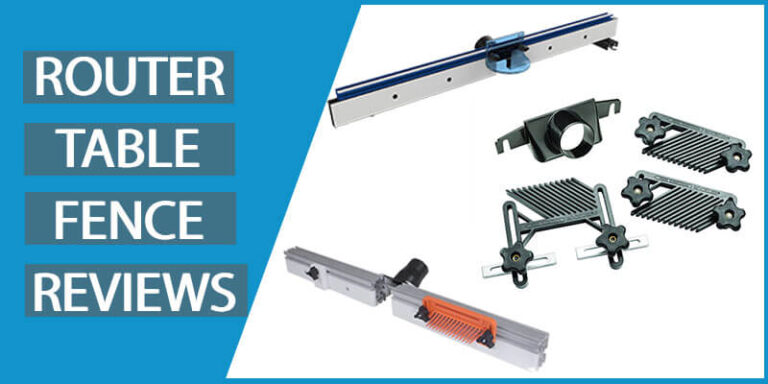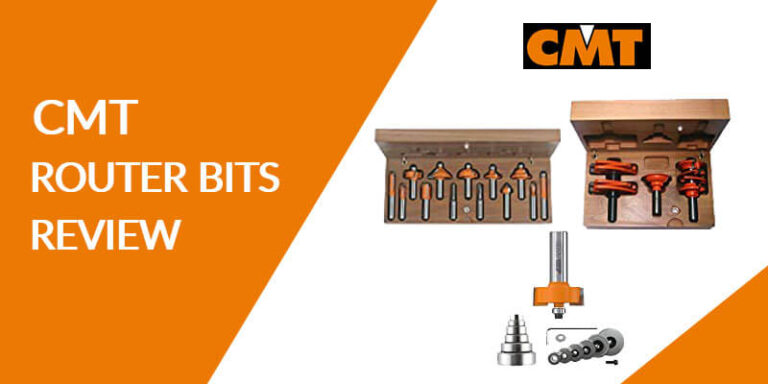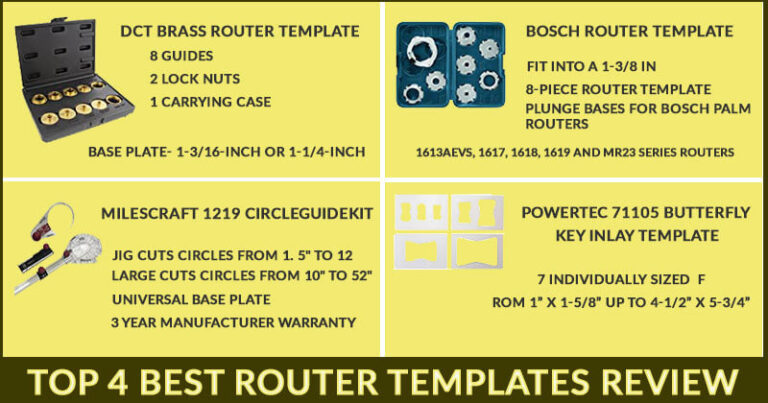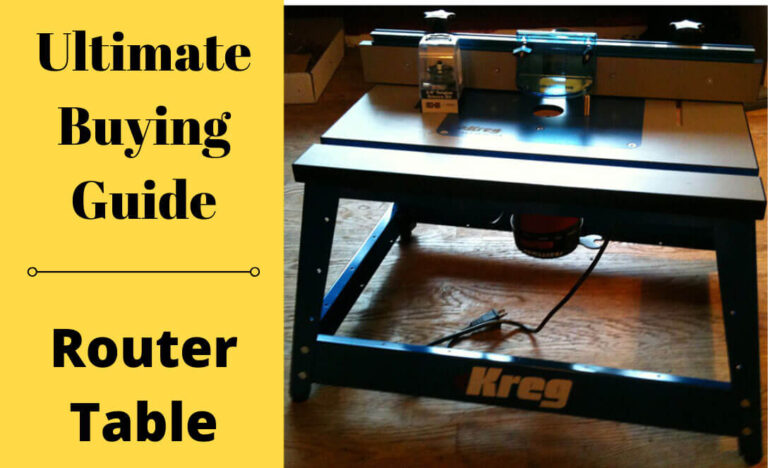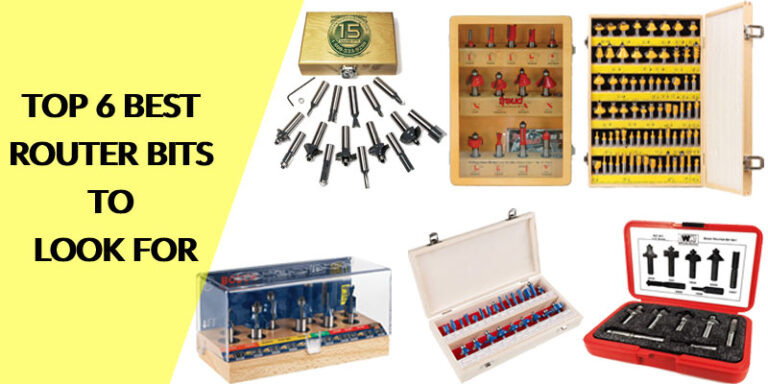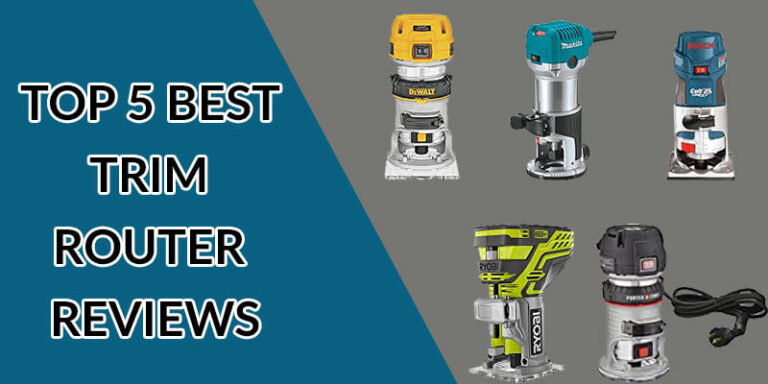5 Best Compact Router of 2024: Reviews and Buyer’s Guide for Ultimate Precision
Getting those grooves right on that dining table is essential if you’re trying to give your customers the best of the best. Your tools play an indispensable role in making this happen.
But how often do you find yourself at the crossroads where you’re having to compromise on quality due to lack of space or the bigger machine being so expensive.
Well, fret no more because you can get the best compact router, which will give you that intricate cut in the smallest of form factors and a lower price. All you have to do is go through this page to find one that best fits you.
5 Best Compact Router Reviews
It’s of utmost importance that you pick your equipment with great care. To get you there faster, our experts have compiled 5 routers that they feel are worthy of being given a chance.
1. DEWALT Router Fixed/Plunge Base Kit –1.25-HP (DWP611PK)
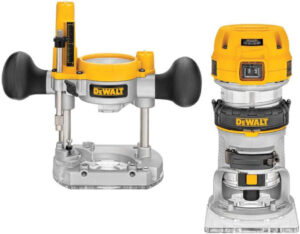
DeWalt is an American brand that manages to capture that American spirit. With a top-of-the-line motor, this 1.25HP beast delivers power unmatched by some larger routers. The machine starts with 16000 RPM and caps out at 27000. This gives you that sweet spot allowing you to shift between a large variety of wood.
The router uses an electrical feedback sensor that allows it to understand any rough patch in the wood. Rather than shutting off the cut, the machine uses its sensor to increase or decrease power, thus keeping the speed at a steady still. This helps you get an uninterrupted clean-cut.
Also, the quality of your cut isn’t only limited to how smoothly you achieve that cut; instead, it further extends to depth as well. This small router allows you to dig into your cut if needed. With the plunge feature, you’ll be able to dive 1.5″ into the wood.
That’s not all, folks! The LED lights at the base of the machine help you when you reach those corners or when you’re working in a dimly lit garage, which makes sure you never go off track and also helps to cut down wastage.
And the only part you won’t like about this router is its price, at a pretty steep value it might close up to the more significant variants. Talking about the price, the product has a massive range of accessories that you can buy individually or ask for a pack. Buying this product gives you a value that surpasses the money you paid for it.
- Highly durable product that looks even more rugged in real life
- Speed range between 16000-27000 RPM giving us the flexibility
- Plunge technology gives you a depth that you never thought you’d need
- Large range of accessories
- Only weighing in at 8pounds
- No carrying case provided
- Prices steeper than most compact speakers
2. Makita 1-1/4 HP Compact Router Kit –RT0701CX3
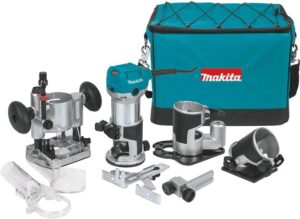
This one isn’t for you if you’re looking for something that you’ll use for small jobs unless you’re willing to spend significant time on something that you won’t use all the time. This is one of the most expensive variants we’ll review, but that’s only due to the value you’re getting at this price.
The 1-1/4HP motor delivers a monster 6.5 amps of power. That’s more than enough for you to cut through most woods like butter. The 6.5amps give you the ability to vary your speeds from 10000-30000 RPM. This lets you find your comfort zone, something you feel will do your workpiece justice.
It has all the bells and whistles you’ll need for a precise cut. The electronic speed control gives the machine flexibility to vary speeds according to the load it is under. This lets you cut through your work without a hitch. The soft-start feature doesn’t start up the device at 30000 RPM; rather, it slowly builds up.
And this makes sure that you’ve got a good grip, or else you might end up with an unusable piece of wood.
To make your handling even more sturdy, the machine has been designed in an ergonomic sense, making sure you minimize faulty cuts and don’t stress out your arm during lengthy jobs. All this is jam-packed into an aluminum housing that makes it job site-proof and prone to mediocre accidents.
- Comes with three different bases
- Ergonomic design
- Fits into any industry-standard template guide
- Double insulated and aluminum shell for durability
- Easy changing of bits with the shaft lock system
- Price is high enough to buy a bigger router
- Depth presets are limited to 3 on plunge bases
3. BOSCH PR20EVS Router Tool, Colt 1-Horsepower 5.6 Amp
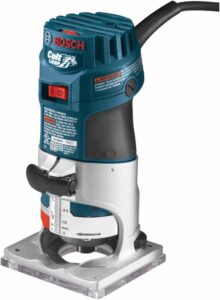
The Germans know their power tools like this one pack a punch like no other. The Colt 1HP powered by a 1HP, 5.6-amp variable motor produces speeds that top out at 35000 RPM. This allows you to work with almost any type of wood. The product is designed not only to push out power but also to provide precision.
With its added finger support, the router allows you to cut/trim at the minutest of detail. Not only that, the router includes an edge guide, but this also lets you adjust your equipment at both macro and micro levels by merely lowering the motor to your preference.
Moreover, the machine shows its real versatility when you get to change the bit. Changing the bit on this couldn’t get easier; using a just spindle lock and a wrench, you can cut down time wastage. The machine also takes in a larger variety of bits ranging up to 1 to 5/16th of an inch.
Furthermore, the constant response circuitry gives the router the ability to make decisions of its own. A naturally occurring material such as wood has different consistencies on the same plank. The machine quickly detects this and adjusts it’s accordingly to match the speed setting you’ve selected.
All this is compactly fit into an extremely durable shell, with an aluminum base. They have increased their strength without compromising on their weight. Surprisingly this is also one of the more affordable models.
- Finger pockets for extra grip and stability
- A larger speed range of 16000 RPM to 35000 RPM
- Small compact design weighing at only 3.3 pounds
- Constant response circuit and soft-start circuitry
- Rugged outer shell with aluminum base
- Not the most powerful horsepower wise
- The depth adjustment must be cleaned and greased regularly to avoid it locking out
4. PORTER-CABLE Router, Compact, 1.25 HP (450)
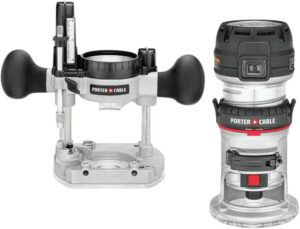
The ergonomically designed body of this machine is really what sets it apart. And the machine allows you to work those long hours without tiring out your arms. This convenient design also looks into the handling of the machine. Providing it with more stability and better grip, you’re able to make those exact cuts.
Moreover, the machine comprises of a powerful motor at 1.25HP; this is tougher than most of the products available in the market. However, the problem is the brand compromises for the lower price by skipping out on the variable speed system. Rather it uses a fixed speed system that produces a constant 27000 RPM.
Furthermore, the soft starting motor makes sure that you get a slow and steady start. This gives you enough time to get the hang of the machine, improving handling and making sure that you get the grooves right so that the cutting is neat and precise.
This product gives you the convenience that can’t be matched by other products. The adjustment ring included makes it ever so easy to change the depth of the cut. By getting those grooves down up to 1/64th-inch, you get the depth your work deserves.
Additionally, this doesn’t provide you with the most versatility, but for the price point, this is great for small jobs. It is a dependable product with a durable metal shell, so you don’t have to worry about it breaking down in the middle of a job.
- A dependable product that’s highly durable
- Low price
- Ergonomic design
- Soft start motor for better handling
- Easy depth adjustment
- Fixed speed cannot be changed
- A standard D base is not included
5. AVID POWER 6.5 Amp 1.25 HP Compact Router – MW104
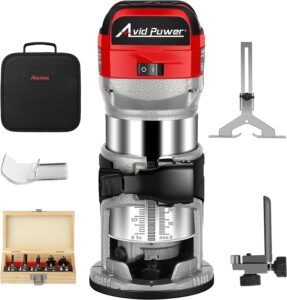
The MW104 is a router that you can’t be wrong with. It’s not a big company that’s making this. So, you’re getting that personal feeling that you’d miss out on buying other products. Even though this is the cheapest of the bunch, it makes no compromises on features or quality.
Also, the 1.25HP motor mounted onto it produces a whopping 6.5amps; this much power delivery ensures that you’re able to cut/trim about any wood. You’re also getting a variable speed control that lets you dial your RPMs from 10000-32000.
Moreover, the device is encased inside a rubber handgrip; this gives you better handling of the device. The LED lights fitted on the base illuminate when the workspace gets dark, so you never have to guess while making your cuts.
This, with the added rack-and-pinion depth adjustment, gives you the precision you usually get on a $200 machine. The aluminum body and base are built for endurance; they provide a sturdy structure and a durable body. This will allow it to take your everyday work pressure and heavy loads.
For the price you’re buying this for, you’ll be getting all the features included in a model from a well-known company. Also, the entire package comes with its case and a few bits. So, you can start with this as a go-to beginner model.
- Affordable price
- Case and other accessories included
- High-speed motor with power output equal to more expensive models
- Ergonomic design and depth adjustment system allowing precision cutting
- LED lights for when you need to reach tight spots
- Might get a bit loud and hot
- The finishing of the product is a bit rough
Features to Consider Before Buying
Before you go into buying your router, we’d like to give you a short idea of things you should be aware of before you make your decision.
-
Performance and Speed
Wood is a versatile material that ranges in hardness, from something you can break with your fingers to something that needs a chainsaw to be dealt with. What you’re looking for is a machine that allows you a range of speeds.
A device with varying speeds will help give you that leverage to move between jobs swiftly. Your router will further need a high-power output; for regular jobs, if the router gives an average of 16000 to 27000 RPM, then you’re good to go.
-
Handling
As you’re dealing with detailing work, it comes without saying that handling possesses utter importance. This might be a little difficult to understand until you get a test run out of it.
But there are some important considerations, like the weight of the product, and good handles with grip pads included. These should give you an approximate idea of what you’re getting into.
-
Electronics
As devices get smarter, our tools must do too. That being said, a great indication that the router you’re buying isn’t from the 18th century would be the addition of computerized features.
Such as the constant response circuitry and soft-start system, both are designed to make handling easier and create a new understanding of precision cutting.
-
Depth Adjustment
This one is a manual feature but something essential to the entire process. Adjustments at a micro-level of even 0.01mm make a grave difference to your work, making this extremely important that the depth adjustment system can be changed smoothly and precisely.
You should also try out the products to find the one whose bit is easier to change. This helps save time and makes the selection process even easier.
Frequently Asked Questions
Here we have some of the most commonly asked queries regarding compact routers:
- How do I ensure I’m using my router properly?
- It’s always wise to feed your wood into the router from left to right; this ensures proper contact between the surface of the wood and the route blades. So, follow the clockwise motion of the blades.
- Start by thoroughly reading the instruction manual that came with your compact router. It will provide specific details about the device, its features, and any safety precautions you should be aware of.
- Always prioritize safety when using a router. Make sure to wear appropriate protective gear, such as safety glasses, ear protection, and gloves. Keep your work area well-lit and organized to avoid accidents.
- Ensure that your router is properly connected to a power source. Use a grounded outlet and check that the power cord is in good condition. Avoid using extension cords if possible, as they may cause voltage drops and affect the router’s performance.
- When working with a compact router, it’s important to securely fasten the workpiece to prevent movement or slipping during operation. This will ensure accurate and safe routing.
- Choose the appropriate router bit for your desired task. Different bits are designed for specific applications, such as cutting, trimming, or shaping different materials. Ensure the router bit is properly installed and securely tightened in the collet.
- Set the cutting depth of your compact router according to the requirements of your project. Most routers have depth adjustment mechanisms that allow you to control the depth of the cut. Make sure to lock the depth adjustment once it’s set to maintain consistency.
- Compact routers often come with variable speed settings. Adjust the speed based on the material you’re working with and the type of cut you want to achieve. Lower speeds are generally suitable for larger bits and harder materials, while higher speeds work well for smaller bits and softer materials.
- Pay attention to the feed direction of the router. It is usually recommended to move the router against the rotation of the bit (left to right) when working on the outer edges of the material, and with the rotation of the bit (right to left) when routing along the edges.
- Ensure that the router base is stable and flat against the workpiece. Hold the router firmly and maintain consistent pressure throughout the routing process. Avoid sudden movements or jerks that can affect the quality of the cut.
- If you’re new to using a compact router, it’s a good idea to practice scrap pieces of the same material before working on your actual project. This will help you familiarize yourself with the router’s operation and ensure you achieve the desired results.
- Can I fit a compact router on a router table?
A router table is usually used when you’re working on a large project. However, you will find some compact routers that’ll be able to attach to router tables.
- Ensure that your compact router is compatible with router table setups. Some compact routers come with specific accessories or adapter kits that allow them to be used with router tables. Check the manufacturer’s instructions or consult the product documentation to confirm compatibility.
- Most compact routers can be detached from their base. Remove the base from the router by loosening any screws or clamps that secure it. This will leave you with the motor unit, which is what you’ll mount to the router table.
- Router tables typically have a mounting plate or insert that serves as a platform for the router. This plate is usually removable and can accommodate different router sizes and models. If your router table comes with a compatible plate or insert for your compact router, attach it to the table according to the table’s instructions.
- Set the router table fence and any other necessary adjustments based on the specific routing task you’ll be performing.
- Place the compact router’s motor unit onto the mounting plate or insert. Align the router’s base with the holes or slots provided in the plate. Use the appropriate screws or clamps to secure the router in place. Follow the router table’s instructions for proper installation.
- Before using the router table, make sure the router is securely mounted and aligned properly. Turn on the router and check for any unusual vibrations or movement. Ensure that the router bit is centered within the router table’s opening and that it rotates freely without hitting any obstructions.
- Some router tables have a mechanism to adjust the height of the router within the table. Use this feature to set the desired cutting depth of the router bit.
- Always follow the safety guidelines provided by the router table and compact router manufacturers. Wear appropriate safety equipment, such as safety glasses and hearing protection, and ensure that the router table is stable and securely positioned.
- Are there lights on the base?
Some come with lights on their bases. This helps you see in badly lit places and makes it easier when you’re trying to follow a particular design. However, models with this included usually carry that extra price.
- Can a compact router be used to make a letter sign?
Yes, we’d suggest this as a great place to look at when you’re thinking about making letter signs. The compact and lightweight design allows you to move along to make the curves on your letters easily. This would be more efficient and quicker than a regular-sized router.
- Determine the size and style of the letter sign you want to create. Sketch out the letters and layout on paper or use design software to visualize the final result.
- Choose a suitable material for your sign, such as wood, acrylic, or high-density foam. Ensure the material is flat, smooth, and adequately sized for the lettering.
- Select the appropriate router bits for cutting the letters. For creating clean and crisp letter edges, straight bits or spiral bits are commonly used. If you want to add decorative details, consider using a V-groove bit or a router bit with a specific profile.
- Fasten the material securely to a workbench or a stable surface using clamps. Ensure it doesn’t move during the routing process.
- If you want consistent letter shapes and sizes, you can create a template or use a lettering guide. A template can be made by printing out the desired letters or cutting them from a thin material like plywood. Place the template on the workpiece and secure it.
- Adjust the cutting depth of the router bit based on the thickness of the material and the desired appearance of the letters. Start with a shallow depth and make test cuts on a scrap piece to ensure accuracy.
- Start routing by guiding the compact router along the template or lettering guide. Move the router smoothly and steadily, following the outlines of the letters. Take care to maintain a consistent speed and pressure throughout the process.
- For letters with inner areas or corners (such as “O” or “A”), you may need to use smaller router bits or change the routing technique. For example, you can start from the inner areas and carefully work your way outward.
- After routing the letters, you may need to sand or file the edges for a smooth finish. Use sandpaper or a file to remove any rough spots or imperfections. Apply any desired paint or finish to enhance the appearance of the letter sign.
- How can I tell the difference between heavy-duty and light-duty routers?
Most of the routers mentioned above are light-duty; they come in a variant of 1-1.5HPmotors and use 3/4″ wide collets. A heavy-duty machine would have a bigger motor and usually use a 1/2″ wide collet.
In terms of size and weight, high-performance routers are generally larger and heavier than light-duty routers. They may have a bulkier body and a larger base. On the other hand, light-duty routers are designed to be more compact and lightweight for ease of use and portability.
When it comes to durability and build quality, high-performance routers are built to withstand demanding and continuous use. They are constructed with sturdier materials, such as metal components, to ensure durability and longevity. Light-duty routers, on the other hand, may feature more plastic components and are designed for occasional or hobbyist use.
High-performance routers often offer a wider range of speed settings, allowing for more precise control over the cutting process. They may feature electronic speed control or variable speed dials to adjust the RPM (revolutions per minute) of the router bit. Light-duty routers typically have fewer speed options and may have fixed speed settings.
When it comes to depth adjustment and plunge capability, high-performance routers commonly offer more precise depth adjustment mechanisms and a greater plunge capacity. They may have micro-adjustment features for fine-tuning the cutting depth and enhanced stability during plunging operations. Light-duty routers, on the other hand, may have simpler depth adjustment mechanisms and limited plunge capabilities.
In terms of bit compatibility and shank size, high-performance routers often support a wider range of router bits, including larger diameter bits and shanks. They may have interchangeable collets to accommodate different shank sizes. Light-duty routers generally have smaller collets and are designed for use with standard-sized router bits.
Price-wise, high-performance routers tend to be more expensive than their light-duty counterparts due to their enhanced features, higher power, and durability.
Final Words
If you are someone who feels that your customers deserve the best for what they’re paying you, then you, too, should use the best tools for the job. In this case, you should get the best compact router. Hopefully, the list provided above will help you choose something that fulfills both your and your customer’s needs.
More Router Information:
Table of Contents









